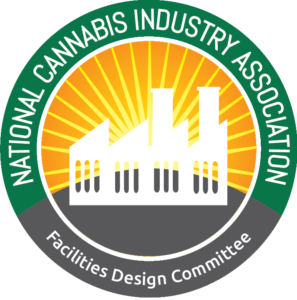 By NCIA’s Facilities Design Committee
By NCIA’s Facilities Design Committee
What to do before you begin
The cannabis industry is an emerging and dynamic industry, but just how leading edge is it in your community? If you are considering constructing a new facility it is important to understand the experience level and “hot buttons” of the Authority Having Jurisdiction (AHJ). Navigating the waters of a new market is different from that of an established market, but both can be treacherous.
In a new market, you may be part of the first round of projects that the AHJ has reviewed for this industry. Codes are meant to be interpreted and every AHJ has a different interpretation. Although this may seem like agriculture, it most likely is not seen that way in the eyes of the AHJ. The facility’s classification (commercial, industrial, agricultural, etc.) is key in driving the balance of the facility design, and it will have a significant impact on schedule and costs.
Many new markets will utilize established markets as a model and plan reviewers may be trained to emulate the existing model markets for code interpretation. It is well worth the research to understand if there is a model market being utilized, as it will create footsteps to follow even if you are the first one on the path.
Whether it is a new market or an existing market, each AHJ has its “hot buttons.” Do your homework to not only determine what these hot button issues are, but understand why, and how it is based in code. Many jurisdictions provide for a “round table” or a pre-submittal review. Take advantage of these processes to ferret out key issues. Do this early in the design stage to avoid surprises later in the process.
When the AHJ takes issue, or has a unique or overly conservative interpretation of the code, take a breath. Choose your battles wisely. If you have a strong case and it is a hill to die on then there are opportunities to work with the AHJ to find a more reasonable interpretation. However, this must be done with a positive and collaborative approach. Don’t win the battle and lose the war. If you have been in the cannabis industry but have not experienced a traditional entitlement process before, there will be many requirements that seem unreasonable. Common sense and past practices are always trumped by current code interpretation unique to each AHJ.
Pick your design and construction team wisely, spend smart money to assemble a seasoned group that has specific specialty knowledge in this industry. When assembled, listen to your team, know your strengths, and recognize theirs. Being part of an emerging industry creates many opportunities and challenges. Your ability to navigate these uncharted waters determines your success.
Construction: Making the best of properly zoned leftovers
In a perfect world, we would purchase existing facilities that are of the proper construction type or a green field site to construct a purpose-built facility. Given the nature of our industry this rarely, if ever, happens. Typically we must make do with the properly zoned leftovers. Understanding how your operations will interact with your existing building’s envelope is key to creating a successful facility.
Creating and maintaining the ideal environment is the ultimate focus, but how your plants function in this environment is only part of the equation. Understanding how your building will function in this unique environment is key to having a successful operation. A major component of this is water vapor – you may not be able to see it but it is all-powerful.
If you are contemplating constructing an indoor cultivation facility in a region that experiences cool temperatures, then you and your team need to understand the concepts and principles involved in a Hygrothermal Analysis. This analysis examines the movement of heat, air, and moisture flow through building enclosure assemblies (walls, roof, floors etc.). Without an understanding of these principles, you risk having significant condensation issues which can result in mold growth, deterioration of building components, and ultimately significant facility costs to properly address.
Since most existing building envelopes were not designed and are not suited to maintain this environment, in most cases the best solution is a “room within a room.” Constructing grow rooms out of insulated metal panels (IMP, think walk-in cooler panels) solves most of the issues. These panels not only provide a complete vapor barrier, but they reduce the volume that must be conditioned and provide ideal wash-down conditions. Thermal bridging is eliminated, and you are provided with an extremely well insulted, controlled, sanitized space.
You may not be able to select the ideal existing building for your facility, but knowing its limitations and appreciating the uniqueness of the environment that is being created is fundamental to your facility’s success. Utilizing products such as IMPs is just one of the methods to address the various pitfalls when working with existing buildings and making the most of the leftovers.
Financing – Show me the Money!
The structure of project funding is extremely important to not only manage a large number of funds properly but to foster an environment that encourages contractor interest while providing security for your investor partners. The continued federal prohibition has eliminated most of the financial mechanisms that other industries utilize when constructing facilities. This coupled with a less-than-stellar initial track record of timely payments to contractors has created a serious issue in our industry, however, there are solutions.
Show me the money… it is literally that simple and the mechanism for this is an escrow account. An escrow account is an account that is set up specifically for the project costs and funds can only be accessed with authorization from both parties (owner and contractor). This ensures that the funds are available and will remain available for the purpose intended. However, parking all the funds required for a project that will take many months or possibly a year to construct has a significant cost of money aspect, but there is a solution.
Contractors generally get reimbursed for work in place 30 days in the rears, if there is an issue with financing, it can take another month to two months to close down a project. Therefore, a contractor’s financial exposure is three months of project cash flow. In lieu of placing the entire project’s funds into the escrow account, three months of cash flow is deposited and then replenished with each monthly draw until the balance in the account equals the cost to complete of the project. This approach minimizes the amount of funds that must be parked in the account while ensuring the funds are available for the contractor.
This topic must be addressed at the onset of the project to ensure that you receive the full benefit of this approach. While you are in the process of selecting your general contractor partner this should be a topic of discussion. Knowing this mechanism is in place will increase contractor and subcontractor interest and may result in lower fees as the approach reduces contractor risk. The structure of project funding and utilization of financial mechanisms outside of mainstream financing is a key component of a successful project.


Follow NCIA
Newsletter
Facebook
Twitter
LinkedIn
Instagram
–